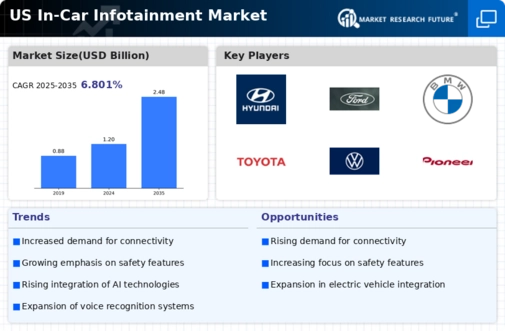Regulatory Push for Enhanced Safety Features
The regulatory push for enhanced safety features is significantly impacting the in car-infotainment market. Governments are increasingly mandating the inclusion of safety technologies in vehicles, which has led to a greater emphasis on integrating these features into infotainment systems. For instance, regulations may require the incorporation of emergency response systems, collision avoidance alerts, and driver monitoring technologies. As of 2025, it is anticipated that nearly 50% of new vehicles will be equipped with advanced safety features linked to infotainment systems. This regulatory environment is likely to drive innovation and investment in the development of safer infotainment solutions, ultimately benefiting consumers and contributing to the growth of the in car-infotainment market.
Technological Advancements in User Interfaces
Technological advancements in user interfaces are playing a pivotal role in shaping the in car-infotainment market. The introduction of touchscreens, voice recognition, and gesture control systems has transformed how users interact with their vehicles. These innovations not only enhance user experience but also improve safety by minimizing distractions. As of 2025, it is estimated that over 70% of new vehicles will feature advanced user interface technologies, reflecting a shift towards more intuitive and user-friendly systems. This trend is likely to encourage manufacturers to prioritize the development of cutting-edge infotainment solutions that align with consumer expectations. Furthermore, the integration of artificial intelligence into these systems may provide personalized experiences, further driving the demand within the in car-infotainment market.
Shift Towards Electric and Autonomous Vehicles
The shift towards electric and autonomous vehicles is reshaping the landscape of the in car-infotainment market. As more consumers opt for electric vehicles, the demand for innovative infotainment systems that complement these technologies is increasing. Electric vehicles often come equipped with advanced infotainment features that enhance the driving experience, such as energy consumption monitoring and charging station locators. Additionally, the rise of autonomous driving technology necessitates the development of infotainment systems that can provide entertainment and information while the vehicle is in motion. This evolving market dynamic suggests that manufacturers will need to adapt their infotainment offerings to meet the unique requirements of electric and autonomous vehicles, thereby driving growth in the in car-infotainment market.
Rising Consumer Demand for Enhanced Entertainment
The in car-infotainment market is experiencing a notable surge in consumer demand for advanced entertainment options. As consumers increasingly seek seamless integration of multimedia content, the market is projected to grow significantly. According to recent estimates, the market could reach a valuation of approximately $30 billion by 2026, driven by the desire for high-quality audio and video experiences. This trend is particularly evident among younger demographics, who prioritize connectivity and entertainment features in their vehicles. The incorporation of streaming services, gaming capabilities, and personalized content is becoming essential for manufacturers aiming to capture this market segment. Consequently, automakers are investing heavily in developing sophisticated infotainment systems that cater to these evolving consumer preferences, thereby propelling the growth of the in car-infotainment market.
Growing Importance of Navigation and Real-Time Data
The growing importance of navigation and real-time data is significantly influencing the in car-infotainment market. As consumers increasingly rely on accurate navigation systems, the demand for advanced GPS and mapping technologies is on the rise. Recent data indicates that nearly 60% of consumers consider navigation features as a critical factor when purchasing a vehicle. This trend has prompted automakers to enhance their infotainment systems with real-time traffic updates, route optimization, and location-based services. The integration of these features not only improves the driving experience but also contributes to overall road safety. As a result, the in car-infotainment market is likely to see continued growth as manufacturers strive to incorporate sophisticated navigation solutions into their offerings.


























Leave a Comment